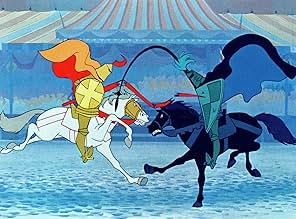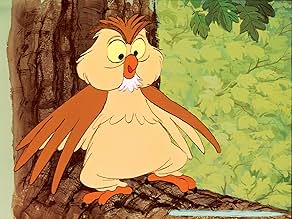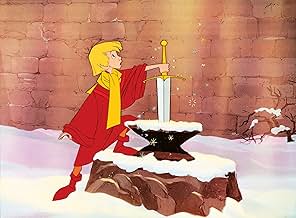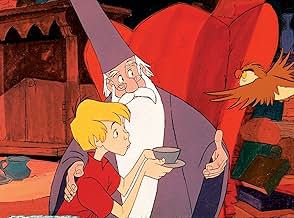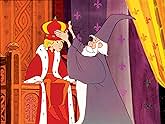NOTE IMDb
7,1/10
109 k
MA NOTE
Un garçon pauvre du nom d'Arthur découvre la puissance de l'amour, de la bonté, de la connaissance et de la bravoure avec l'aide d'un magicien appelé Merlin, pour devenir l'un des rois les p... Tout lireUn garçon pauvre du nom d'Arthur découvre la puissance de l'amour, de la bonté, de la connaissance et de la bravoure avec l'aide d'un magicien appelé Merlin, pour devenir l'un des rois les plus appréciés de l'histoire anglaise.Un garçon pauvre du nom d'Arthur découvre la puissance de l'amour, de la bonté, de la connaissance et de la bravoure avec l'aide d'un magicien appelé Merlin, pour devenir l'un des rois les plus appréciés de l'histoire anglaise.
- Nommé pour 1 Oscar
- 1 victoire et 1 nomination au total
Rickie Sorensen
- Wart
- (voix)
Sebastian Cabot
- Sir Ector
- (voix)
- …
Karl Swenson
- Merlin
- (voix)
Martha Wentworth
- Madam Mim
- (voix)
- …
Norman Alden
- Sir Kay
- (voix)
Alan Napier
- Sir Pellinore
- (voix)
Richard Reitherman
- Wart
- (voix)
Robert Reitherman
- Wart
- (voix)
Jack Albertson
- Knight in Crowd #1
- (non crédité)
Barbara Jo Allen
- Scullery Maid
- (voix)
- (non crédité)
Fred Darian
- The Minstrel in opening sequence
- (voix)
- (non crédité)
James MacDonald
- The Wolf
- (voix)
- (non crédité)
- …
Tudor Owen
- Knight in Crowd
- (voix)
- (non crédité)
Thurl Ravenscroft
- Black Bart
- (voix)
- (non crédité)
Histoire
Le saviez-vous
- AnecdotesAlthough Walt Disney never knew it, he himself was character designer Bill Peet's model for Merlin. Peet saw them both as argumentative, cantankerous, but playful and very intelligent. Peet also gave Merlin Walt's nose. This was the second instance in which Walt unknowingly served as model for a wizard, the first being the wizard Yensid from the Sorcerer's Apprentice in Fantasia (1940). This explains why the character was given the name Yensid. This read backwards is Disney.
- GaffesThroughout the entire film Wart's voice keeps on changing from being child-like to adult-like. One of the easiest spots to notice this is in the throne room towards the end when Wart is trying to get somebody else to take his place. He says "Oh Archimedes, I wish Merlin were here!" in his adult voice, then the camera goes to a distant view and he calls "Merlin, Merlin" in his child voice.
- Versions alternativesThe UK DVD version omits part of Madam Mim's first line "Sounds like someone's sick. How lovely. I do hope it's serious. Something dreadful." She now says "Sounds like someone's sick. How lovely."
- ConnexionsEdited into Le Livre de la jungle (1967)
- Bandes originalesThe Legend of the Sword in the Stone
(1963) (uncredited)
Music and Lyrics by Richard M. Sherman and Robert B. Sherman
Sung by Fred Darian
Commentaire à la une
This movie is another proof of the high quality of the classic Disney films. Today feature films are quite funny too... but they based mostly on simple, crude jokes and spoofing of other topical movies (remember the bullet time-spoof in "Shrek"). There is no substance to think about in it. You can see them, laughing about them...and forgot them almost completely a few years later. Who will remember, i.e., "Ice Age" or "Madagascar" in 40, 50 or 60 years? The old Disney classics are different, there are timeless! "The Sword in the Stone" contains a lot of joyful gags too, but no gag stands above the characters, no joke was made only to fill a hole in the plot. The story, the plot, and the characters are primary. And Disney add not only joyful gags. As Walt himself once said: "For every laugh, there should be a tear." Disney take children always quite seriously, and a lot of his early films contains a lesson for life, sometimes the lesson can be very sad and cruel, like in "Bambi", sometimes lesser sad, like in "The Sword in the Stone"... but can anybody forget the cute little girl squirrel, that was left by Wart, desperately crying and with a broken heart? And Merlin's closing words about love: "Well, yes, in its own way... yes, I'd say it's the most powerful force on Earth"!
This is one of the main ingredient of the famous Disney Magic: Joy and tragedy! Another is the art of hand drawn animation. The quality of the animation went downwards at Disney after WW-II too, slowly, but surely. But in 1963 cel-animation was still on a high level. Not so good as in the golden Era, when "Fantasia", "Pinocchio" or especially "Bambi" set the utmost high standards of perfectionism, but quite better than in "Hercules", "The Lion King" or "The Rescuers down under". 7 of 10 stars for "The Sword in the Stone"! It is not the best of all Disney films, but quite better and deeper than the most of the modern CGI movies!
This is one of the main ingredient of the famous Disney Magic: Joy and tragedy! Another is the art of hand drawn animation. The quality of the animation went downwards at Disney after WW-II too, slowly, but surely. But in 1963 cel-animation was still on a high level. Not so good as in the golden Era, when "Fantasia", "Pinocchio" or especially "Bambi" set the utmost high standards of perfectionism, but quite better than in "Hercules", "The Lion King" or "The Rescuers down under". 7 of 10 stars for "The Sword in the Stone"! It is not the best of all Disney films, but quite better and deeper than the most of the modern CGI movies!
Meilleurs choix
Connectez-vous pour évaluer et suivre la liste de favoris afin de recevoir des recommandations personnalisées
Détails
Box-office
- Budget
- 3 000 000 $US (estimé)
- Montant brut aux États-Unis et au Canada
- 12 000 000 $US
- Week-end de sortie aux États-Unis et au Canada
- 2 230 614 $US
- 27 mars 1983
- Montant brut mondial
- 12 000 000 $US
- Durée1 heure 19 minutes
- Rapport de forme
- 1.37 : 1(original & negative ratio, open matte)
Contribuer à cette page
Suggérer une modification ou ajouter du contenu manquant

Lacune principale
By what name was Merlin l'Enchanteur (1963) officially released in India in English?
Répondre






